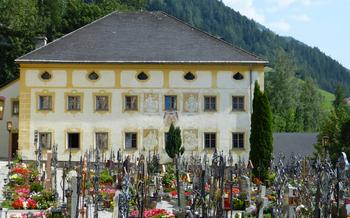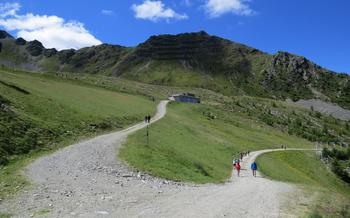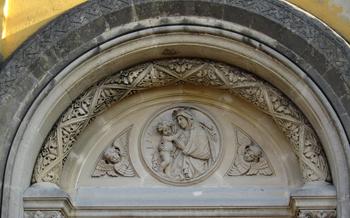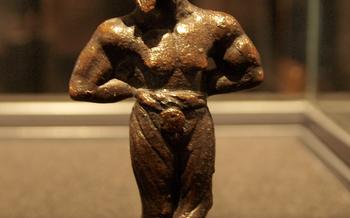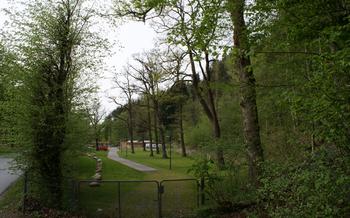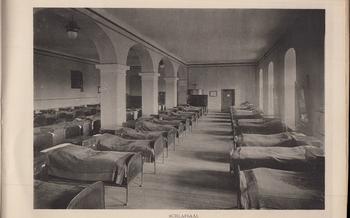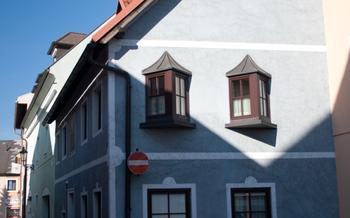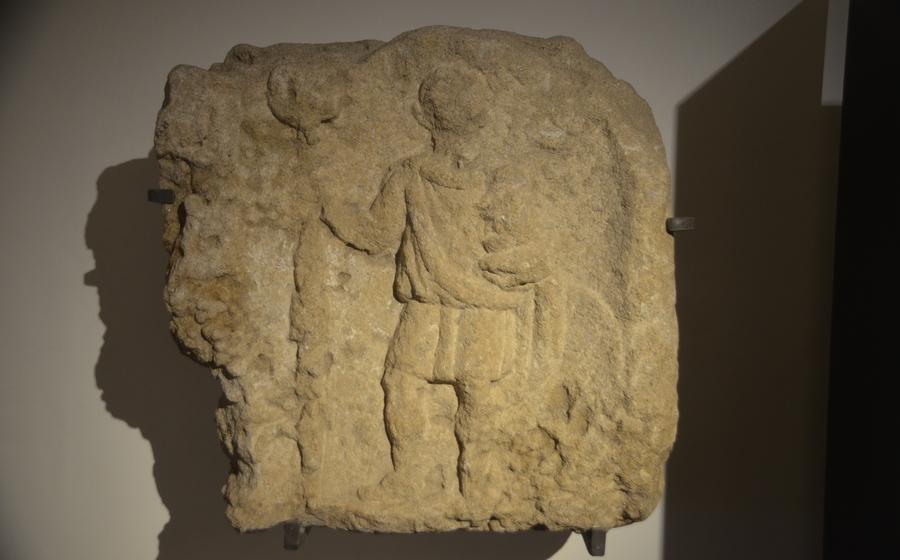
Lauriacum Museum (Roman Museum Enns)
- A Roman Settlement in Austria
- Exploring the Lauriacum Museum
- Tracing the Footsteps of Roman Soldiers
- Civilian Life in Roman Lauriacum
- The Mithras Cult and Its Mysteries
- The Roman Amphitheater: A Stage for Spectacles
- Interactive Activities for Hands-On Learning
- Guided Tours for Deeper Insights
- Souvenirs and Publications for History Buffs:
- Accessibility and Facilities for Visitors:
- Educational Programs and Workshops
- Special Exhibitions and Temporary Displays
- Enns: A Town Steeped in Roman History
- Insider Tip: Hidden Gems of the Museum
A Roman Settlement in Austria
Lauriacum, the ancient Roman city of Enns, was a significant military camp and provincial capital in the Roman province of Noricum. Its strategic location on the banks of the Enns River made it a crucial frontier outpost along the Limes Noricus, the Roman border fortifications that marked the northern boundary of the empire. Archaeological excavations at Lauriacum have unearthed a wealth of artifacts that shed light on daily life in the Roman Empire and the role of the city in securing its frontiers. The Lauriacum Museum, located within the former Roman military camp, houses a remarkable collection of these artifacts, providing visitors with a glimpse into the rich history of this Roman settlement in Austria.
Exploring the Lauriacum Museum
The Lauriacum Museum is strategically located within the former Roman military camp, offering visitors a unique opportunity to immerse themselves in the history of this ancient settlement. The museum building itself is a testament to the enduring legacy of Roman architecture, featuring a replica of a Roman gate that serves as a symbolic entrance to the past. Inside, interactive exhibits and multimedia presentations bring the Roman era to life, providing visitors with a dynamic and engaging experience. Curated displays of artifacts, including weapons, tools, jewelry, and pottery, offer a glimpse into the daily lives of Roman soldiers and civilians who once called Lauriacum home.
Tracing the Footsteps of Roman Soldiers
The Lauriacum Museum offers a glimpse into the lives of the Roman soldiers who were stationed at the camp. Through the examination of military equipment, uniforms, and weaponry, visitors can gain insights into the daily routines and challenges faced by these soldiers. The museum also explores the camp's layout and defensive structures, providing a sense of the strategic importance of Lauriacum in securing the Roman Empire's frontiers. By understanding the role of the Roman army in this region, visitors can appreciate the significance of Lauriacum as a key military stronghold and its contribution to the maintenance of Roman power in the province of Noricum.
Civilian Life in Roman Lauriacum
The Lauriacum Museum provides a glimpse into the daily lives of civilians residing in Roman Lauriacum. Numerous artifacts on display shed light on their economic activities and social customs. Pottery, glassware, and coins offer clues to the local economy and trade networks.
Exhibits showcase the diverse range of occupations pursued by Lauriacum's inhabitants. From artisans and craftsmen to merchants and farmers, the town bustled with economic activity. Visitors can examine tools and equipment used in various trades, gaining insights into the skills and expertise of the Roman settlers.
Religion played a significant role in the lives of Lauriacum's civilians. Artifacts related to various religious practices, such as votive offerings and statuettes, provide evidence of the town's religious diversity. The museum also explores the integration of Roman and local Celtic religious beliefs, highlighting the cultural exchange and assimilation that occurred in the Roman settlement.
The Mithras Cult and Its Mysteries
The Lauriacum Museum also sheds light on the intriguing Mithras cult, a mystery religion that gained popularity among Roman soldiers. Artifacts related to Mithraic rituals and beliefs, such as sculptures, reliefs, and inscriptions, provide valuable insights into the practices and beliefs of this secretive cult.
Of particular significance is the Mithraeum, a temple dedicated to Mithras, which was discovered in Enns. This well-preserved temple offers a glimpse into the rituals and ceremonies conducted by Mithras followers. Visitors can explore the temple's layout, examine the elaborate wall paintings and sculptures, and learn about the symbolism and significance of Mithraic iconography.
By delving into the mysteries of the Mithras cult, the Lauriacum Museum provides a unique opportunity to understand the religious beliefs and practices that shaped the lives of Roman soldiers stationed in Lauriacum. It offers a fascinating glimpse into the spiritual world of the Roman Empire and the diversity of religious practices that existed during that era.
The Roman Amphitheater: A Stage for Spectacles
The Enns amphitheater stands as a testament to the Romans' love of entertainment and spectacle. Built during the 2nd century AD, this impressive structure could accommodate up to 6,000 spectators. Its elliptical arena, measuring 65 by 45 meters, was the stage for gladiatorial contests, animal fights, and other public performances.
The amphitheater's design reflects the ingenuity and engineering prowess of the Romans. The seating tiers, divided into three sections, were carefully arranged to provide optimal views of the action below. The outer wall, adorned with blind arches and pilasters, added architectural grandeur to the structure.
Gladiatorial combats were a particularly popular form of entertainment in Roman society. These contests, often brutal and deadly, pitted professional fighters against each other or against wild animals. The amphitheater in Enns provided a venue for these spectacles, where spectators could witness the skill and courage of the gladiators.
Beyond gladiatorial combats, the amphitheater also hosted a variety of other events, including chariot races, acrobatic performances, and theatrical productions. These spectacles served as a source of entertainment and amusement for the Roman population, bringing people together from all walks of life.
Today, the Enns amphitheater stands as a reminder of the Roman Empire's enduring legacy. Although partially ruined, it remains an impressive sight that transports visitors back in time to the days of gladiators and public spectacles.
Interactive Activities for Hands-On Learning
The Lauriacum Museum offers a variety of interactive exhibits that allow visitors to engage with Roman history in a hands-on way. These exhibits are designed to make learning about the Romans fun and accessible for people of all ages.
Children and families can participate in hands-on activities that teach them about Roman daily life and customs. They can dress in Roman clothing, play Roman games, and explore replicas of Roman artifacts. These activities help to bring Roman history to life and make it more relatable for younger visitors.
Interactive exhibits also allow visitors to explore different aspects of Roman culture in greater depth. For example, there is an exhibit that allows visitors to learn about Roman writing by using a stylus to write on a wax tablet. Another exhibit lets visitors try their hand at Roman cooking by following recipes from ancient Roman cookbooks.
These interactive elements enhance the museum experience by making it more engaging and memorable for visitors. They allow people to learn about Roman history in a fun and interactive way, and they help to bring the past to life.
Guided Tours for Deeper Insights
To enhance your visit to the Lauriacum Museum, consider joining one of the guided tours led by knowledgeable museum guides. These tours provide in-depth explanations of the museum's exhibits and their significance, allowing you to gain a deeper understanding of Roman history and culture. The guides are experts in their field and can answer your questions, providing insights and perspectives that you might miss on your own.
Tours can be customized to suit your interests and preferences, whether you are interested in military history, daily life in Roman Lauriacum, or the Mithras cult. The guides can tailor the tour to focus on specific topics or artifacts, ensuring that you get the most out of your visit.
Guided tours are available in various languages, making the museum accessible to visitors from all over the world. They are also a great option for families with children, as the guides can adapt their explanations to make the tour engaging and informative for younger visitors.
By joining a guided tour, you will not only learn more about Roman history but also gain a deeper appreciation for the artifacts and exhibits on display. It is an excellent way to make the most of your visit to the Lauriacum Museum and immerse yourself in the fascinating world of ancient Rome.
Souvenirs and Publications for History Buffs:
The Lauriacum Museum offers a unique opportunity for visitors to take home a piece of Roman history through its well-stocked museum shop. Here, history enthusiasts can browse a carefully curated selection of souvenirs, books, and replicas that reflect the museum's rich collection and the fascinating history of Lauriacum.
Among the must-haves are replicas of Roman coins, jewelry, and pottery, allowing visitors to own a tangible piece of the past. Detailed guidebooks and catalogs provide in-depth information about the museum's exhibits and the Roman history of the region. For those seeking a deeper dive, research papers and academic publications offer comprehensive insights into the latest archaeological discoveries and research findings.
The museum shop also features a range of unique gifts and mementos, such as Roman-inspired clothing and accessories, making it the perfect place to find a special souvenir for yourself or a loved one. By purchasing these items, visitors not only take home a piece of history but also support the museum's ongoing research and educational initiatives, ensuring the preservation and dissemination of knowledge about Roman culture for generations to come.
Accessibility and Facilities for Visitors:
The Lauriacum Museum welcomes visitors from all backgrounds and abilities. The museum is wheelchair accessible, with ramps and elevators providing easy access to all floors. Restrooms, including accessible facilities, are conveniently located within the museum premises. For a more comfortable visit, a cloakroom is available to store personal belongings.
To enhance the visitor experience, audio guides in multiple languages are offered, allowing visitors to explore the exhibits at their own pace and in their preferred language. Multilingual signage throughout the museum provides clear directions and information for international visitors.
To cater to the needs of families and groups, the museum offers a range of facilities. A dedicated children's corner provides interactive activities and games, making learning about Roman history fun and engaging for young visitors. A café within the museum premises offers refreshments and a place to relax and reflect on the museum's exhibits.
Educational Programs and Workshops
The Lauriacum Museum is dedicated to fostering a deeper understanding of Roman history and archaeology through educational programs and workshops. These interactive learning experiences are designed for schools, groups, and individuals of all ages, providing a unique opportunity to delve into the fascinating world of ancient Rome.
In collaboration with local educational institutions, the museum offers a range of workshops and lectures that explore various aspects of Roman life, culture, and history. These programs are tailored to different age groups and interests, ensuring that everyone can find something to engage and inspire them.
The museum's commitment to education extends beyond its walls, as it actively participates in outreach programs, bringing Roman history to life for communities throughout the region. Through these initiatives, the museum aims to promote the preservation and dissemination of knowledge about Roman culture, fostering a greater appreciation for our shared historical heritage.
Special Exhibitions and Temporary Displays
The Lauriacum Museum is renowned for its special exhibitions and temporary displays, which offer visitors fresh perspectives and insights on Roman civilization. These exhibitions showcase new discoveries, research findings, and collaborations with other museums and institutions. By bringing unique artifacts and exhibits to Enns, the museum provides visitors with an opportunity to explore specific themes related to Roman history, art, and culture. These special exhibitions add depth and variety to the museum's permanent collection, ensuring that there is always something new to discover for visitors of all ages and interests.
Enns: A Town Steeped in Roman History
Enns, the modern-day town where the Lauriacum Museum resides, is a treasure trove of Roman history. Its roots can be traced back to the Roman military camp of Lauriacum, making it one of the oldest continuously inhabited settlements in Austria. Beyond the museum, visitors can explore other Roman sites and attractions that paint a vivid picture of the town's rich past.
The Stadtmuseum Enns, located in the heart of the town, houses a collection of artifacts and exhibits that further illuminate Enns' Roman heritage. Through interactive displays and guided tours, visitors can delve deeper into the lives of Roman soldiers, civilians, and the intricate workings of the Roman Empire.
For those seeking an immersive experience, Enns offers self-guided and guided walking tours that lead visitors through the town's Roman landmarks. These tours showcase the remnants of Roman fortifications, temples, and public buildings, providing a tangible connection to the town's ancient past.
Enns invites visitors to explore its Roman roots and discover the enduring legacy of the Roman Empire. By venturing beyond the Lauriacum Museum, travelers can immerse themselves in the town's rich history and gain a deeper appreciation for the remarkable contributions of the Romans to the region's cultural heritage.
Insider Tip: Hidden Gems of the Museum
Beyond the main exhibits, the Lauriacum Museum holds a hidden gem in its basement: a collection of Roman tombstones. These artifacts provide a unique glimpse into Roman funerary customs and beliefs about the afterlife. Visitors can view these tombstones up close, gaining insights into the lives and deaths of the Roman inhabitants of Lauriacum. The inscriptions on the tombstones reveal personal details, such as names, ages, and occupations, offering a tangible connection to the past. Exploring this lesser-known corner of the museum is a rewarding experience for those seeking a deeper understanding of Roman culture and history.


